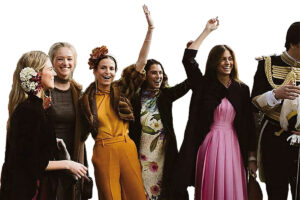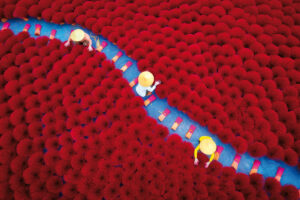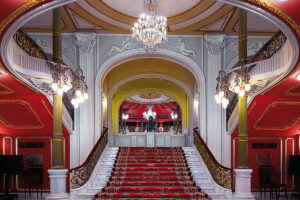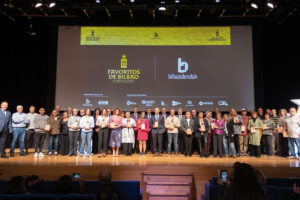Javier Viar, farmacopola harto conocedor de las galénicas del Arte, dirige éste Museo, verdadera joya ya intemporal. Será él quien nos descubra su fórmula magistral, el “secundum artem”… nunca mejor dicho.
El bello entorno que circunda el Museo de Bellas Artes es el marco ideal para comenzar un viaje -podríamos llamar iniciático- por ésta institución centenaria. Entramos por la limpia estructura del edificio moderno (comenzado en 1970 y que fija la actual fisonomía desde el 2001) para contemplar el atrio que nos pilota a la tienda, la fascinante exposición temporal de Lüpertz y secciones de servicios.
A través de una gran puerta de cuarterones penetramos en la maquinaria que hace posible el funcionamiento del Museo. Viar, nos recibe rebosando “savoir faire”, en su despacho repleto de libros. Un gran Chillida preside el espacio.
De boticario a boticario, le pregunto a Javier Viar por la célebre fórmula: “Yo creo que el anclaje en la realidad histórica del último siglo y medio de Bilbao, del País Vasco, del territorio de Vizcaya, y ser fiel a ese carácter de enraizamiento a nuestra propia historia”.
Pero es “historia en movimiento”. Javier prefiere la denominación “historia” que “tradición”. En cualquier caso el Museo se mueve. Terminadas las Guerras Carlistas (1875), roto el cerco de Bilbao, la ciudad florece de forma extraordinaria. Con la industrialización aparece una burguesía ilustrada y culta: sofisticada. Después de la creación del primer Museo (1908) se produce un fenómeno muy interesante. Al estallar la Gran Guerra, la neutralidad española y el cierre de las siderurgias europeas beligerantes, produjo un fenomenal enriquecimiento.
“El museo -nos comenta Viar- es la guinda de ese enriquecimiento. Aparecen al menos dos protagonistas: los coleccionistas, que compran en las subastas, especialmente en París, y aparecen los artistas, muchos de ellos hijos de burgueses. Así mismo, las instituciones son sensibles. Podíamos hablar de una burguesía oligárquica, pues mandaban”.
Naturalmente, buena parte de las colecciones de aquellos coleccionistas y de aquellos artistas (especialmente del entorno vasco) forman parte ahora de los fondos del Museo.
Paseo quedamente por las salas -llamémoslas antiguas-. Suntuosos suelos de mármol, cenefas de madera nobilísima, paredes en deliciosos tonos de la paleta cálida de los Sienas. Impresiona la “Majestad de Cristo en cruz” delicado, casi etéreo. En un anónimo catalán del XIII, en madera tallada y con una preciosa policromía.
“El segundo Museo nació como un Museo de arte moderno, convirtiéndose en un Museo de arte contemporáneo, es decir, nace bajo el mismo concepto del MOMA de Nueva York: obras contemporáneas que al convertirse en clásicos se venderían al Metropolitan”. Con gracia, Javier Viar comenta que eso no ocurrió nunca pues el MOMA consiguió unas colecciones tan maravillosas que jamás se desprendieron de ellas. “Aquí, la fusión de los dos primigenios museos -arte contemporáneo y bellas artes- hizo que todas las colecciones quedaran en el mismo sitio, casi desde el principio”.
Contemplo ahora el enorme (226×282) “Lot y sus hijas” de Orazio Gentileschi (1628). El escabroso tema de la embriaguez de Lot es aquí tratado con una gran delicadeza no falta de erotismo. Por cierto, Orazio fue el padre de Artemisia Gentileschi, también pintora ya puramente caravaggística. Javier Viar tiene a pocos metros de su templo, otro “monstruo sagrado”: el Guggenheim.
“No solo convivimos perfectamente, sino que somos sinérgicos. No obstante, son dos realidades muy distintas. El fenómeno Guggenheim, que implica la transformación de la ciudad, nace de la necesidad de rehabilitar un espacio citadino. Algo completamente diferente a nuestro proyecto. Nosotros hemos copiado cosas de ellos, por ejemplo el Patronato Mixto, típicamente anglosajón. Aunque perteneciente a las instituciones, tenemos patronos privados que sostienen muchos aspectos del Museo”.
Es difícil no estremecerse al mirar “El beso de la reliquia” de Sorolla (1893), ganadora de varios premios coetáneos. Autor que representa lo que para mi es la segunda “Edad de Oro” de la pintura española. Cerca, me mira con picardía la “Venus de la poesía” de Julio Romero de Torres. Rodeada por una luz mágica aparece frente a mi el fabuloso “Retrato de la Condesa de Mathieu de Noailles” con una fascinante mirada y una “tenue” realmente seductora. Lienzo de Ignacio Zuloaga Zabaleta (1913) hijo de Eibar.
Charlando de los fondos del Museo, nos dice Javier Viar: “Las adquisiciones las duplicamos con las donaciones. Mira, hablamos del orden de seis millones de euros en adquisiciones frente a algo más de doce millones a través de donaciones. El mes pasado nos han donado un Sorolla que vale 240.000 euros. La implicación de éste Museo con la sociedad civil es muy fuerte. Aún cuando la donación no está bien tratada en España, la donación de piezas es constante, comenzando por un gran aficionado al arte como fue Laureano Jado, coleccionista, y que fue Presidente de la Comisión Ejecutiva del Museo”.
Abandono las “salas antiguas y modernas” y desembarco en las “salas contemporáneas”, una preciosa museística, fáciles de recorrer, luminosas. Allí encaro a Bacon y su “Lying Figure in Mirror” (1971), siempre desasosegante, Bacon. Todas las salas (éstas y las otras) están trufadas de esculturas. Me paro delante de “Intxixu” (1973) de Nestor Basterretxea Arzadun. Su aspecto totémico y la factura de cierto “ready made” son espléndidos.
Quiero poner al Director en un brete y le invito a escoger una pintura, una escultura y una obra gráfica. “Un cuadro… hay dos en realidad… pero te diré uno: La Lucrecia de Lucas Cranach que acabamos de comprar. Es la pieza más importante que hemos adquirido siendo yo Director”, dice Viar con un sanísimo orgullo. “De escultura te diría un hierro de Julio González, precioso, y además no es habitual, por que lo que se vende en el mercado normalmente son bronces, que provienen de hierros, pero no, éste es un hierro”. “¿Obra gráfica?… Pues, lógicamente, una de Chillida, tenemos muy buenas obras de él… pero… espera, vamos a seguir con lo clásico para no sembrar cizaña. Durero, un grabado de la Virgen con el Niño, maravilloso. Y así tenemos dos alemanes de tres”… Javier ríe.
Los gabinetes de educación (Gabinetes didácticos) y los de restauración son dos fulcros del Museo. “Desde el punto de vista didáctico y de forma organizada unas 40.000 personas, entre niños de colegios, ikastolas… además de personas mayores, naturalmente. Siempre tuvimos una clara orientación a este tema. La labor restauradora es fantástica. El gabinete de restauración de este Museo tiene un reconocido prestigio. Hoy, por ejemplo, el jefe del gabinete está impartiendo unos cursos en Madrid. Y tenemos muy buenas relaciones con otros museos que nos permiten acudir a intervenciones en otras ciudades, y que otros expertos vengan aquí a ayudarnos ocasionalmente. Me siento muy orgulloso. Además, la Fundación Iberdrola dota una beca para este tema en particular”.
A Javier Viar le gustaría tener un Piero de la Francesca. “Sería la coronación absoluta”.
Al calor de la simpatía de mi interlocutor y rodeados de libros y catálogos, conversamos de ARCO, la feria madrileña que se celebra simultáneamente con éste reportaje.
“En ARCO siempre hay algo que merece la pena. De hecho, ésta tarde voy a verlo. No hace mucho adquirimos dos obras en ARCO: un Apple precioso, extraordinario, y un dibujo de Chillida. Independientemente de los balances anuales que se pueden hacer, ARCO es una feria y tiene que estar orientada al mercado y ahí es donde tiene su personalidad y su función. ARCO ha ayudado a difundir, por ejemplo, las vanguardias italianas y alemanas”.
Viar tiene ilusiones para su Museo.
“Hay que procurar que las ilusiones estén en línea con las posibilidades, es decir, se contrasten con la realidad, que es a lo que te obliga la gestión. Tengo planeadas exposiciones temporales para los próximos tres años, perfectamente encajadas en fechas con contratos firmados. Ahora tenemos a Lüpertz, en verano traeremos la muestra “Arte japonés y japonismo”, arte del que tenemos muy buenos fondos. Las colecciones propias nos sirven para investigar, toda vez que nuestro presupuesto para investigación es limitado. Terminaremos el año con el Hiperrealismo”.
Y a la puerta de su despacho me despido de éste farmacéutico, que ha transmutado los albarelos en obras de arte. Agraciado taumaturgo, diría yo.
• Nota 1: El 2012 fue el año record de visitas: 295.600. El 80% son autóctonos.
• Nota 2: Este entrevistador también es farmacéutico.
Javier Viar, chemist and a connoisseur of the chemistry of Art, manages this Museum, and timeless jewel. He will give us an insight into his master formula, the «secundum artem.»
The beautiful landscape surrounding the Museum of Fine Arts is the ideal place to start our trip –which some might call an initiation- around this century-old institution. We walk through the clean structure of the modern building (building on this extension started in 1970 and the museum has maintained its current appearance since 2001) to see the atrium leading us towards the visitor shop, the fascinating temporary exhibition of Lüpertz and the management offices.
Through a large paneled door, we delve deeper into the mechanics of Museum operations. Viar, welcomes us overflowing with «savoir faire» into his book-lined office. A large Chillida piece presides over his office. Chemist to chemist, I ask Javier Viar about the famous formula: «I think the key lies in maintaining an anchor in the historical reality of the last century and a half of Bilbao, the Basque Country and the territory of Biscay, and staying true to the roots of our own history».
But it is «history in motion». Javier prefers the term «history» rather than «tradition». In any case, the Museum moves forward. After the Carlist Wars (1875), and the end of the siege of Bilbao, the city flourished dramatically. Through the process of industrialization an enlightened, educated and more sophisticated bourgeoisie appears. After the creation of the first Museum (1908) an interesting phenomenon occurred: during the outbreak of the Great War, steel mills in the warring countries were forced to close. However, due to the neutrality of Spain, a great enrichment took place.
«The museum Viar tells us is the icing on this enrichment. Two characters emerged: Collectors, who bought at auctions, especially in Paris, and artists, many of them children of bourgeoisie came to the fore. Institutions took notice of this and let the oligarchic bourgeoisie lead.”
Naturally, many collections gathered by those collectors and artists (especially from the Basque Country) are now part of the Museum’s portfolio.
As I walk quietly through the Museum, passing sumptuous marble floors, friezes made of the finest wood, and walls painted with warm sienna tones. I am impressed by the «Majesty of Christ on the Cross» which is a delicate, almost ethereal work by an anonymous 13th century Catalonian, carved into wood with beautiful polychrome.
«The second museum was created as a museum of modern art, becoming a museum of contemporary art born under the concept of the MOMA in New York: where contemporary works of art on becoming “classics” would be sold to Metropolitan.» Curiously, Javier Viar says that never actually happened because the MOMA had amassed such wonderful collections that they never wanted to part with them. «Here, the merger of the two museums, classic and contemporary art, meant that all collections would stay in the same place, almost from the beginning.»
I now contemplate the huge (226×282) «Lot and his Daughters» by Orazio Gentileschi (1628). The thorny issue of Lot’s drunkenness is treated here with great delicacy and no lack of eroticism. Interestingly, Orazio Gentileschi was the father of Atemisia Gentileschi also a painter faithful to the Caravaggisti style. Javier Viar has just a few meters from his temple, another «sacred monster»: the Guggenheim.
«Not only do we live together perfectly well, but we are synergistic. However, there are two very different realities. The Guggenheim phenomenon, which has contributed to the transformation of the city, came out of the need to regenerate an urban space, something completely different from our project. We have copied things from them, such as introducing a Joint Board, a typically British concept. Although it remains a public institution, private stakeholders help manage many aspects of the museum.»
It’s hard not to feel a quiver when looking at «Kiss of the relic» by Sorolla (1893), winner of several contemporary awards in its day. This is an artist that represents what is for me the second «Golden Age» of Spanish painting. Nearby, looking at me mischievously is the «Venus of poetry» by Julio Romero de Torres. Surrounded by a magical light in front of me is the fabulous «Portrait of the Countess Mathieu de Noailles» with a fascinating look on her face and a really seductive aura by Ignacio Zuloaga Zabaleta (1913) from Eibar.
On the matter of the Museum portfolio, Javier Viar says: «The amount of art we procure is doubled by the amount we receive as donations. If we consider that we are looking at six million euros of acquisitions compared to over twelve million received through donations. Last month a Sorolla worth 240,000 euros was donated to us. This demonstrates the strength of the relationship of the Museum with the public. Even though donation is not well regarded in Spain, the donations we receive are constant, starting with art enthusiasts such as Laureano Jado, a collector, who was Chairman of the Executive Committee of the Museum.”
As I leave the «classic and modern rooms» and land in the «contemporary rooms,» it is a beautiful museum, bright and easy to navigate. There I come face to face with Bacon´s «Lying Figure in Mirror» (1971), always unsettling. All the rooms are peppered with sculptures. I stand before «Intxixu» (1973) Nestor Basterretxea Arzadun. Its totemic appearance and «ready made» appeal are splendid.
I want to put the Director in a jam and ask him to choose a painting, a sculpture and an installation. «One painting … I have two actually … but I will tell you about one: Lucas Cranach’s Lucretia that we have just bought. It is the most important piece that we have acquired since I became Director,» Viar says with healthy pride.
«For a sculpture I would chose the iron piece by Julio González, lovely, and it is highly unusual as what is sold are usually bronze sculptures based on an iron model, but this is iron.»
«An installation? … Well, of course, one of Chillida, we have many good examples of his work … but wait, we will continue with classic pieces to avoid controversy. Durer´s engraving of the Virgin and Child is wonderful. And so we have two German´ out of three there»… Javier laughs.
The education and restoration committees are two of the Museum´s key focuses. «From an educational point of view we attract some 40,000 people, including school children, ikastolas (Basque language schools) … plus seniors, naturally. We have always had a clear focus on this topic. The restoration work is fantastic and the restoration committee of the Museum has undeniable prestige. Today, for example, the chief of the committee is teaching some courses in Madrid. And we have very good relationships with other museums that allow us to attend conferences in other cities, and occasionally other experts come to help us. I feel very proud. In addition, the Iberdrola Foundation provides a scholarship for this particular area.”
Javier Viar would like to have a Piero della Francesca. «It would be the absolute jewel in the crown”.
Viar has high expectations for his Museum.
«We must ensure that the expectations are in line with the possibilities, ie, are contrasted with reality, which is what management forces you to do. I have planned temporary exhibitions for the next three years, with the dates all planned out and signed contracts. Now we have Lüpertz and in the summer we will bring in the exhibition «Japanese art and Japanism» an area which is strong in our portfolio. These collections also allow us to carry out research, since our research budget is limited. We end the year with Hyperrealism.”
And at the door of his office, I leave this chemist who has transmuted albarello medicinal pots into artworks. I’d say, he is a lucky magician.
• Note 1: 2012 marked a record number of visitors: 295,600. 80% are locals.
• Note 2: This interviewer is also a chemist.
Texto: Antonio Terán y Pando • Imágenes: Museo de Bellas Artes de Bilbao • Foto exterior del Museo: Joseba del Villar
[gmedia id=103]








